Study on the Certification Policy of Zero-Energy Buildings in Korea
Abstract
:1. Introduction
1.1. Background of the Study
1.2. Current Status of Energy Building Policies Overseas
1.3. Objectives of the Study
2. Main Body
2.1. Mandatory ZEB Road Map
2.2. Certification System of Building Energy in Korea
2.2.1. Building Energy Efficiency Rating
2.2.2. ECO2, a Building Energy Assessment Tool
2.3. Study on Definition of ZEBs in Korea
2.3.1. Definition of ZEB Level
2.3.2. Level of ZEB Certification
2.3.3. Total Primary Energy, NRPE, RPE, and Energy Self-Sufficiency Rate
- Note (1):
- RPE (renewable primary energy per unit area (kWh/m2)
- = ∑((NRE production - energy amount required to produce NRE) × corresponding primary energy conversion coefficient)/evaluated area.
- Note (2):
- Total primary energy per unit area (kWh/m2)
- = Non-renewable primary energy (NRPE) per unit area + renewable primary energy (RPE) per unit area.
2.3.4. Other Certification Criteria of ZEBs
2.4. Current Status of ZEB Certification
3. Conclusions
- (1)
- The ZEB certification in Korea proposes a stepwise certification level that can be certified from the nearly ZEB (NZEB) level to a plus level. The rating level of the ZEB was defined as those meeting a 1++ building level, which were the top 5% of buildings based on the existing building energy efficiency rating database.
- (2)
- The rating was defined as satisfying the passive level of the building and differentiating the NRE production. The rating was assigned for every 20% section based on the NRE self-sufficiency rate, which is determined through the total primary energy, non-renewable primary energy (NRPE), renewable primary energy (RPE), and the self-sufficiency rate.
- (3)
- The current certification status of the ZEBs in Korea exhibited that as the rating increased, the total sum of the required first energy amount was reduced by 50% in the case of Rating ZEB 1 compared to that of Rating 1++ of building energy-efficiency rating, and the NRE production more than quadrupled.
- (4)
- The NRE self-sufficiency rate level (level of certification rating) was inversely proportional to the total area, which showed a limitation according to the building environments since the ZEBs in Korea are evaluated based on the NRE produced only on-site.
Author Contributions
Funding
Acknowledgments
Conflicts of Interest
References
- International Energy Agency. Energy Policies of IEA Countries—The Republic of Korea 2012 Review; International Energy Agency: Paris, France, 2012. [Google Scholar]
- Concerted Action EPBD. 2016 Implementation the Energy Performance of Buildings Directive (EPBD): Featuring Country Reports; ADENE: Lisboa, Portugal, 2015; p. 594. Available online: https://epbd-ca.eu/ca-outcomes/2011-2015 (accessed on 20 April 2020).
- Danish Transport and Construction Agency. Danish Building Regulations 2015, 2015.12; Danish Transport and Construction Agency: Copenhagen, Denmark, 2015. [Google Scholar]
- Feist, W. Lernzielkatalog “Zertifizierter PassivhausPlaner”; Passive Haus Institute: Darmstadt, Germany, 2015. [Google Scholar]
- IPEEC. Building Energy Efficiency Requirements in Building Codes, Energy Efficiency Policies for New Buildings; International Energy Agency (IEA): Paris, France, 2008; pp. 477–488. [Google Scholar]
- Cui, C.; Niu, J.J. Energy-saving technology strategy 2011 and Enlightenment to us. Energy China 2011, 33, 10–14. [Google Scholar]
- American Society of Heating, Refrigerating, and Air-Conditioning Engineers. ANSI/ASHRAE/IES Standard 90.1-2016: Energy Standard for Buildings Except Low-Rise Residential Buildings; ASHRAE: Atlanta, GA, USA, 2016. [Google Scholar]
- Joint Related Ministries. 2030 Modification & Complementation of the Greenhouse Gas Reduction Roadmap; Ministry of Environment: New Delhi, India, 2018; p. 3. [Google Scholar]
- Green Buildings Construction Support Act No. 16418. Available online: http://www.law.go.kr/lsSc.do?tabMenuId=tab18§ion=&eventGubun=060101&query=%EB%85%B9%EC%83%89%EA%B1%B4%EC%B6%95#liBgcolor0 (accessed on 20 April 2020).
- Andaloro, A.P.E.; Salomone, R.; Ioppolo, G.; Andaloro, L. Energy certification of buildings: A comparative analysis of progress towards implementation in European countries. Energy Policy 2010, 28, 5840–5866. [Google Scholar] [CrossRef]
- Jo, J.-H. A Study on Evaluation Criteria and Evaluation Tool for Energy Performance of internal and external Building, Construction Technique/Sangyong, Special Project II—Zero Energy Building Policies and Trends of Internal and External Building. 2017, p. 23. Available online: http://www.auric.or.kr/User/Rdoc/DocRdoc.aspx?BrsDataBaseName=RDOC&PrimaryKey=350201&DBNM=RDCR#.XvGVO3duKUl (accessed on 20 April 2020).
- Kim, Y.; Jang, H.K.; Yu, K.H. Study on Extension of Standard Meteorological Data for Cities in South Korea Using ISO 15927-4. Atmosphere 2017, 8, 220. [Google Scholar] [CrossRef] [Green Version]
- Certification Standards of Building Energy Efficiency Rating and Zero Energy Building, Annexed Table 2. In Notice No. 2018-675 of the Ministry of Land, Infrastructure and Transport. Available online: http://www.law.go.kr/admRulSc.do?tabMenuId=tab107&query=%EA%B1%B4%EC%B6%95%EB%AC%BC%EC%97%90%EB%84%88%EC%A7%80%20%ED%9A%A8%EC%9C%A8%EB%93%B1%EA%B8%89#AJAX (accessed on 20 April 2020).
- Ministry of Land. The Second Green Building Basic Plan, Green Architecture Division. 2020; pp. 1–12. Available online: http://www.molit.go.kr/USR/NEWS/m_71/dtl.jsp?id=95083381 (accessed on 20 April 2020).
- Zero-Energy Building Information Site in Korea Energy Agency. Available online: https://zeb.energy.or.kr/BC/BC00/BC00_01_001.do (accessed on 20 April 2020).


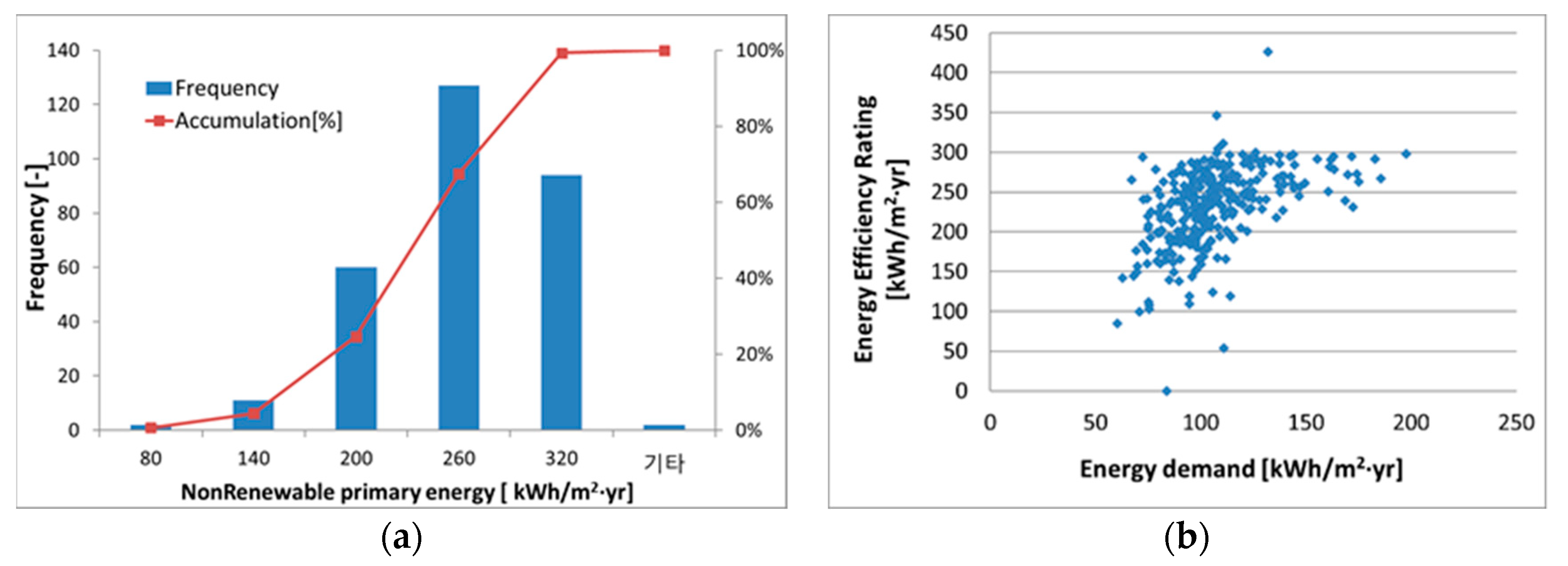
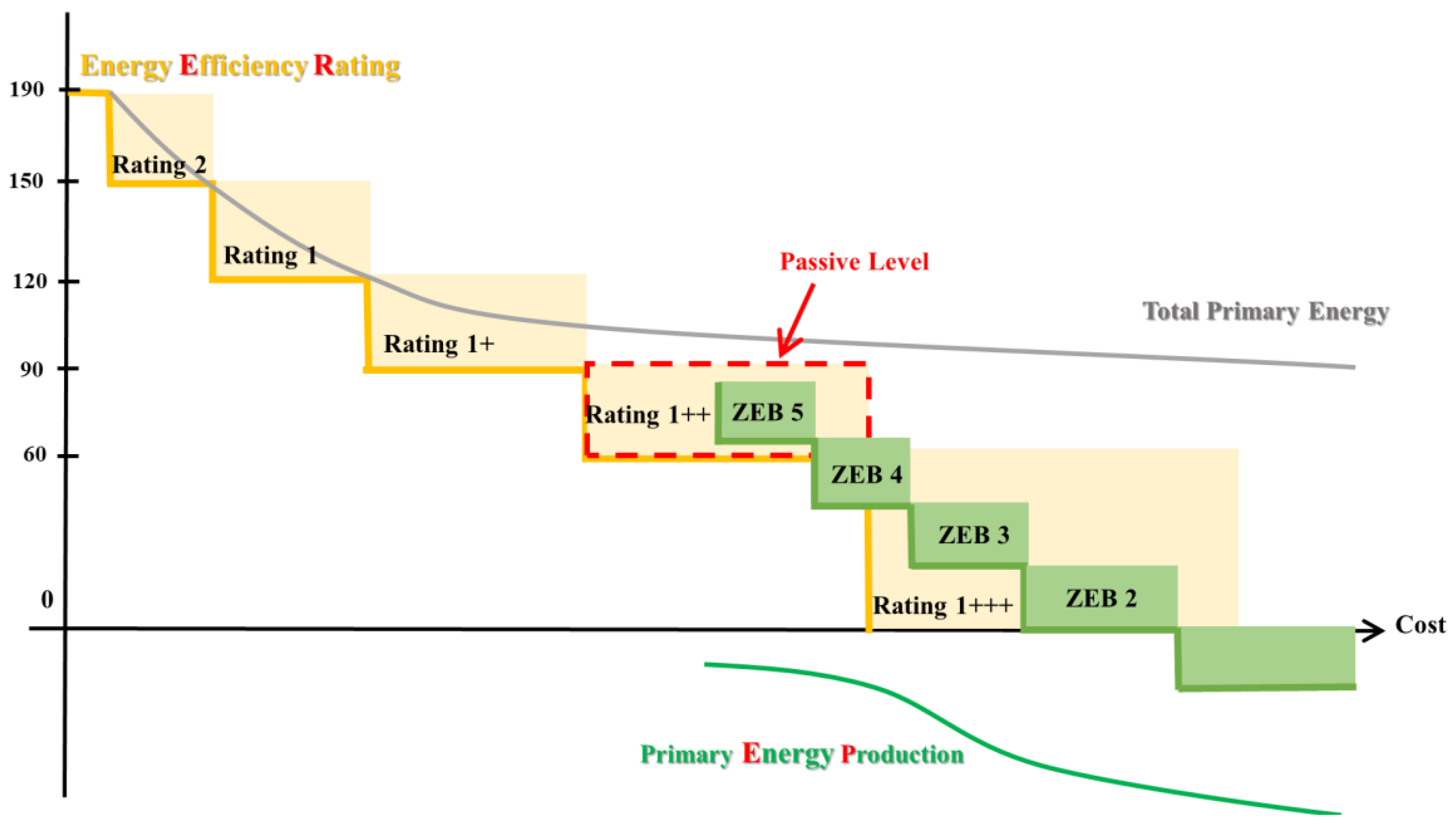

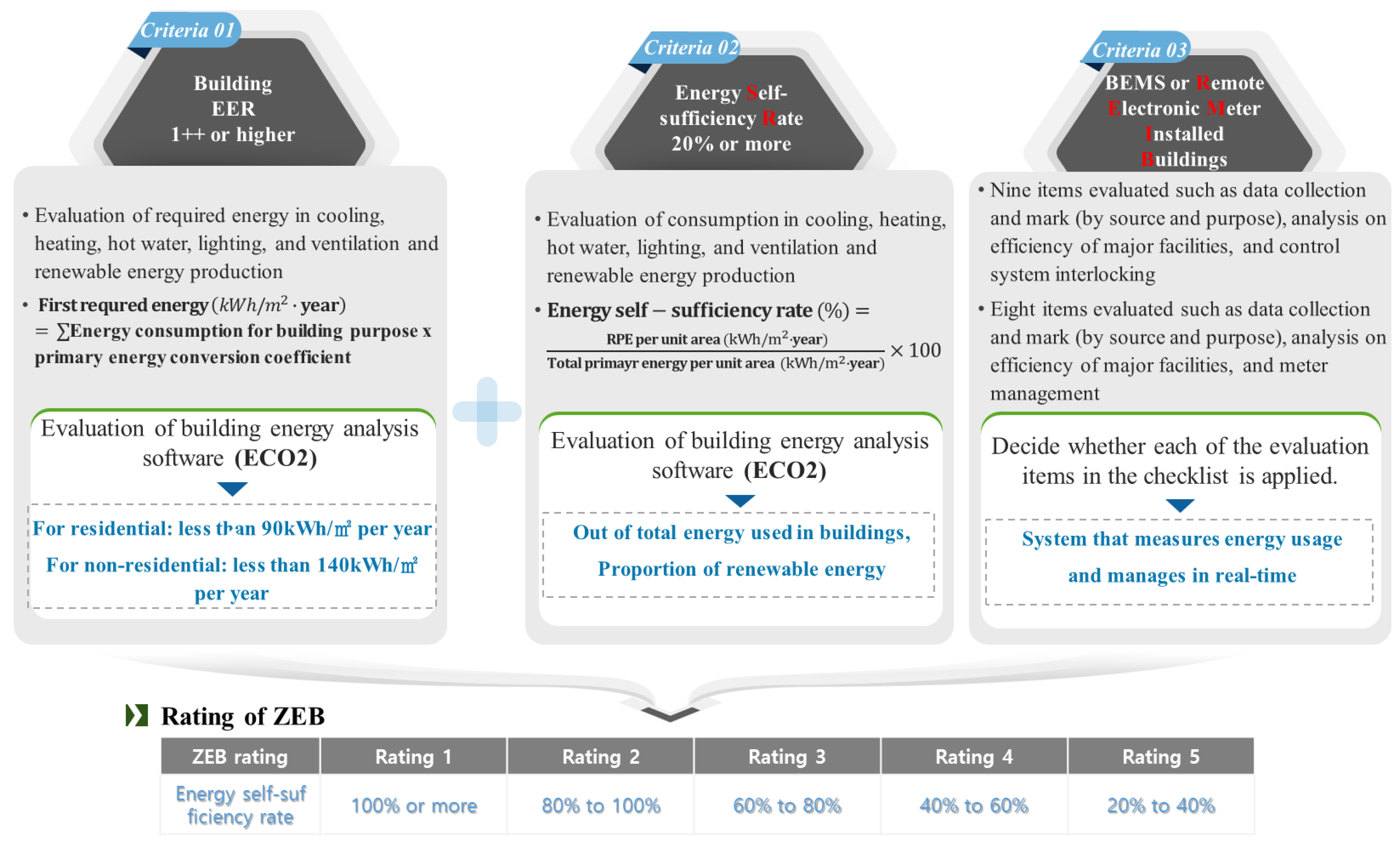

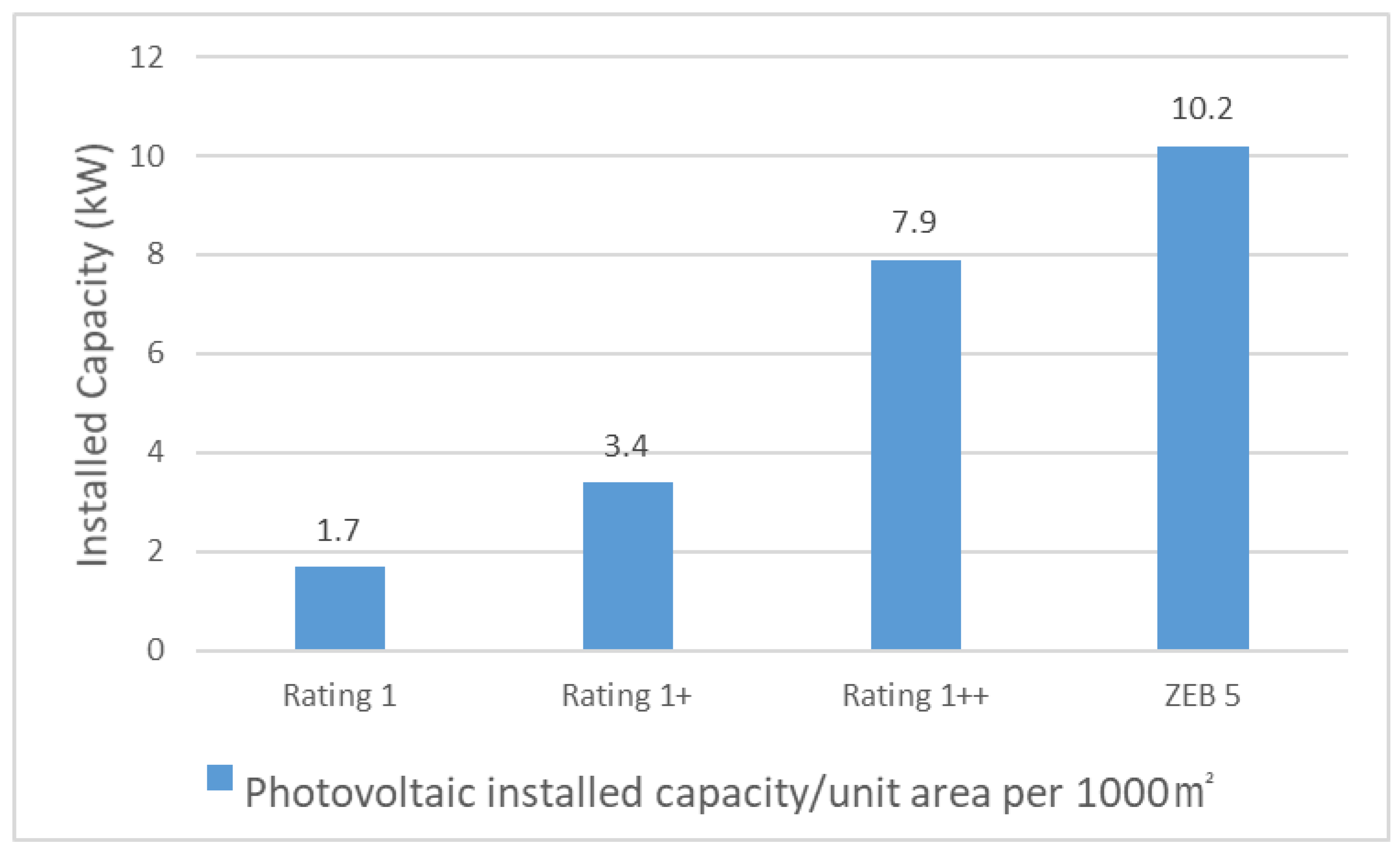
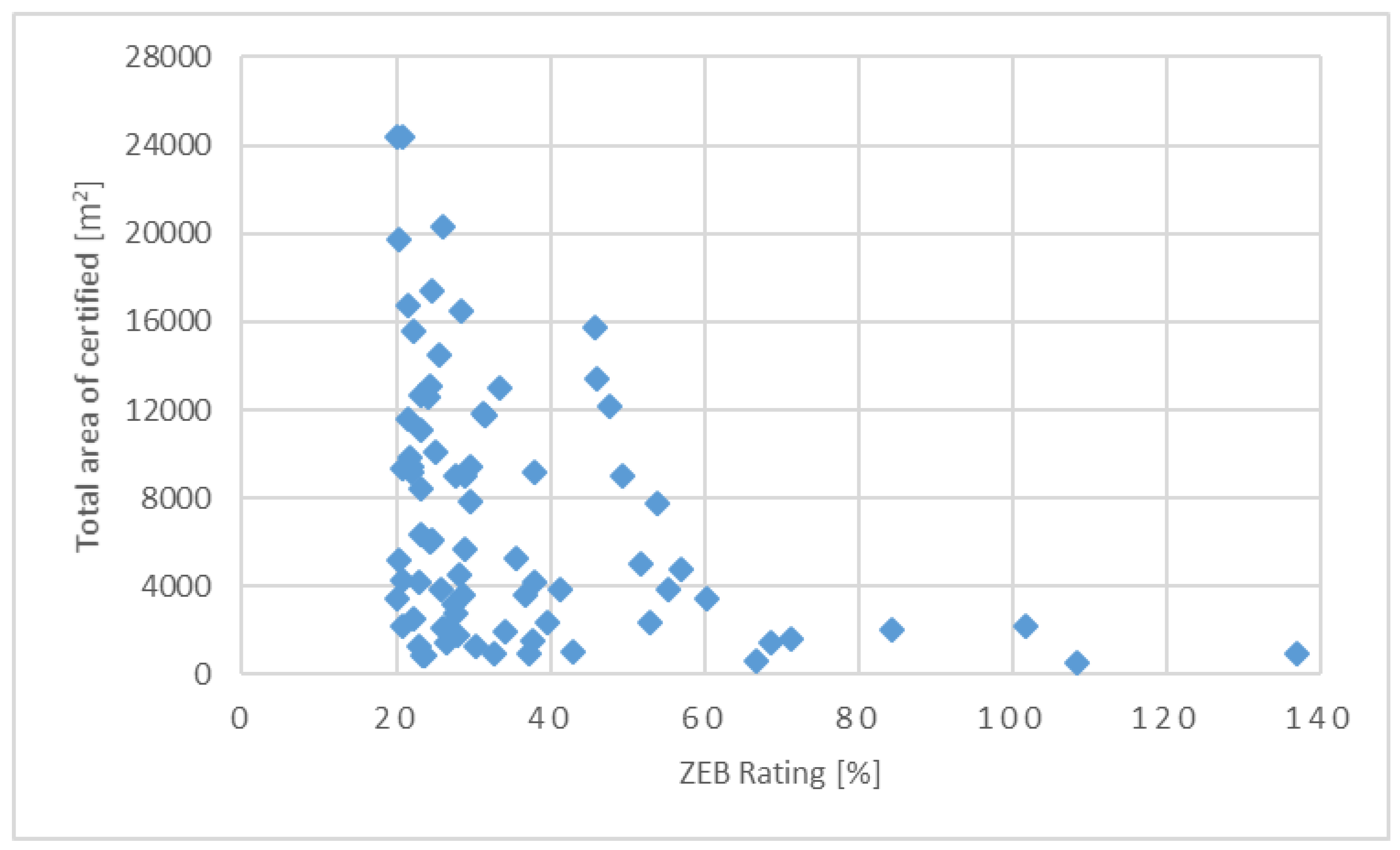
| Label | Annual Non-Renewable Primary Energy (kWh/m2) | |
|---|---|---|
| Residential Buildings | Non-Residential Buildings | |
| 1+++ | Under 60 | Under 80 |
| 1++ | More than 60 and under 90 | More than 80 and under 140 |
| 1+ | More than 90 and under 120 | More than 140 and under 200 |
| 1 | More than 120 and under 150 | More than 200 and under 260 |
| 2 | More than 150 and under 190 | More than 260 and under 320 |
| 3 | More than 190 and under 273 | More than 320 and under 380 |
| 4 | More than 230 and under 270 | More than 380 and under 450 |
| 5 | More than 270 and under 320 | More than 450 and under 520 |
| 6 | More than 320 and under 370 | More than 520 and under 610 |
| 7 | More than 370 and under 420 | More than 610 and under 700 |
| Rating | Rating 5 | Rating 4 | Rating 3 | Rating 2 | Rating 1 |
|---|---|---|---|---|---|
| No. of certificates (–) | 64 | 11 | 8 | 1 | 3 |
| Proportion (%) | 74 | 13 | 9 | 1 | 3 |
© 2020 by the authors. Licensee MDPI, Basel, Switzerland. This article is an open access article distributed under the terms and conditions of the Creative Commons Attribution (CC BY) license (http://creativecommons.org/licenses/by/4.0/).
Share and Cite
Kim, Y.; Yu, K.-H. Study on the Certification Policy of Zero-Energy Buildings in Korea. Sustainability 2020, 12, 5172. https://doi.org/10.3390/su12125172
Kim Y, Yu K-H. Study on the Certification Policy of Zero-Energy Buildings in Korea. Sustainability. 2020; 12(12):5172. https://doi.org/10.3390/su12125172
Chicago/Turabian StyleKim, Yeweon, and Ki-Hyung Yu. 2020. "Study on the Certification Policy of Zero-Energy Buildings in Korea" Sustainability 12, no. 12: 5172. https://doi.org/10.3390/su12125172
APA StyleKim, Y., & Yu, K.-H. (2020). Study on the Certification Policy of Zero-Energy Buildings in Korea. Sustainability, 12(12), 5172. https://doi.org/10.3390/su12125172




